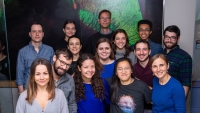Kellendonk Lab

Location and Contact Information
Principal Investigator
Our laboratory uses mouse genetic tools in an effort to understand the biology that underlies the symptoms of schizophrenia. Schizophrenia is characterized by three symptom clusters: the cognitive, negative and positive symptoms. While the positive symptoms – which include disordered thought processes, hallucinations and delusions – are the most characteristic feature of the disorder, such symptoms are more difficult to model in the mouse. In contrast, cognitive and negative symptoms of the disorder – including deficits in working memory and motivation – have behavioral readouts homologous to humans in the mouse. These symptoms are poorly understood, difficult to treat and their severities are a better predictor for the long-term prognosis of patients than the degree of positive symptoms.
Our approach uses observations made in patients with schizophrenia (e.g. with brain imaging) and then seeks to “model” these observations as closely as possible in the mouse. This allows for establishing causality between a specific brain alteration and changes in behavior. Using this approach we hope to achieve three main goals:
1) To better understand the basic neuronal mechanisms that support cognitive and motivated behaviors
2) To inspire new studies in humans based on observations made in the mouse
3) To identify new treatment strategies for enhancing cognition and motivation
Methods: We use transgenic and viral approaches to expresses dopamine D2 receptors or optogenetic and chemo-genetic tools in defined circuits of the brain. We then combine behavioral analyses with slice and in vivo physiological outcome measures to understand how circuit function regulates behavior.
Ongoing projects:
- To determine how dopamine D2Rs in the striatum regulate striatal circuit function and behavior
- To determine the role of thalamic D2Rs in circuit function and behavior
- To determine how the thalamus and cortex interact in supporting working memory
- To study the impact of an environmental risk factor for schizophrenia, maternal immune activation, on offspring behavior and physiology
Lab Members
Isabel Bravo
Daniel Lowes, PhD
Ariadna Kim Silva
Pedro Olivetti, MD PhD
Joshua Taliaferro
Arturo Torres Herraez, PhD
Joseph Villarin, PhD
Select Publications
Benoit L., Holt. E., Pisano L., Fusi S., Harris A.Z, Canetta S., Kellendonk. C. Adolescent thalamic inhibition leads to long-lasting impairments in prefrontal cortex function (2022) Nature Neuroscience 10.1038/s41593-022-01072-y
E.F. Gallo, J. Greenwald, E. Teboul, K. Martyniuk, N. Zarrelli, Y. Li, J.A. Javitch, P. Balsam, C. Kellendonk (2021) Dopamine D2 receptors modulate the cholinergic pause and inhibitory learning Mol Psychiatrydoi.org/10.1038/s41380-021-01364-y
Donthamsetti P., Gallo E.F., Buck D.C., Stahl E.L., Zhu Y., Lane R.L., Bohn L.M., Neve K.A., Kellendonk C., Javitch J.A. (2020) Arrestin recruitment to dopamine D2 receptor mediates locomotion but not incentive motivation Molecular Psychiatry 25(9):2086-2100
Gallo E.F., Meszaros J., Sherman J.D., Chohan M.O., Teboul E., Choi C.S., Moore H., Javitch J.A., Kellendonk C. (2018) Accumbens Dopamine D2 Receptors increase motivation by decreasing inhibitory transmission to the ventral pallidum Nature Communications 14;9(1):1086.
Bolkan S., Stujenske J.M., Parnaudeau S., Spellman T.J, Rauffenbart C., Abbas A., Harris A.Z., Gordon J.A., Kellendonk C. (2017) Thalamic projections sustain prefrontal activity during working memory maintenance Nature Neuroscience doi:10.1038/nn.4568
Carvalho Poyraz F., Holzner E., Bailey M.R., Meszaros J., Kenney L., Kheirbek M.A., Balsam P.D., Kellendonk C. (2016) Decreasing striato-pallidal pathway function enhances motivation by energizing the initiation of goal directed action J. Neuroscience 36(22):5988-6001
S. Canetta, S. Bolkan, N. Padilla-Coreano, L.J. Song, R. Sahn, N.L. Harrison, J.A. Gordon, A. Brown, C. Kellendonk (2016) Maternal immune activation leads to selective functional deficits in offspring parvalbumin interneurons. Molecular Psychiatry 21(7):956-68
Cazorla M, de Carvalho FD, Chohan MO, Shegda M, Chuhma N, Rayport S, Ahmari SE, Moore H, Kellendonk C. (2014) Dopamine D2 receptors regulate the anatomical and functional balance of basal ganglia circuitry. Neuron. 81:153-164.
Parnaudeau S, O'Neill PK, Bolkan SS, Ward RD, Abbas AI, Roth BL, Balsam PD, Gordon JA, Kellendonk C. (2013) Inhibition of mediodorsal thalamus disrupts thalamofrontal connectivity and cognition. Neuron. 77:1151-1162.
